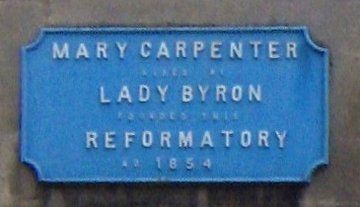
Mary Carpenter
‐
Social reformer and founder of the National Indian Association
Place of birth
Place of death
Bristol
About
Mary Carpenter was the daughter of a Unitarian minister, Lant Carpenter, whose family moved to Bristol in 1817. In 1833 the Brahmo Samaj reformer Raja Rammohun Ray visited Bristol and was an important influence upon Mary Carpenter, encouraging an interest in India. Carpenter moved into Red House Lodge in Bristol in 1858 and entertained a number of Indian visitors to Britain, including Satyendranath Tagore, the elder brother of Rabindranath, who arrived in Britain in 1863 and was the first Indian to join the Indian Civil Service through the competitive ranks, his companion Manomohun Ghose, Joguth Chunder Gangooly, an ordained minister from Boston, and Rakhal Das Haldar, who visited Britain for education in the 1860s.
Mary Carpenter visited India four times; the first was in 1866, when she was accompanied by Manomohun Ghose, returning to India after having been called to the Bar, and the daughter of Dr Goodeve Chuckerbutty from Calcutta, who had been sent to England for education. Her first port of call was to Satyendranath Tagore in Bombay, and on this trip she met Sasipada Banerji, who was to return the visit in 1871.
During her third visit to India in 1870, Keshub Chunder Sen discussed with Carpenter the idea of forming an association in Britain. Sen visited her in Bristol in June 1870, and in September 1870 Mary Carpenter inaugurated the Bristol Indian Association. This Association was subsequently renamed the National Indian Association and was designed to promote social reform (particularly female education) in India and provide a meeting place for Indian visitors to Britain. In January 1871 Carpenter began producing the Journal of the National Indian Association. After her death in 1877, the headquarters of the Association were transferred to London.
Albion Banerji, Sasipada Banerji, Manomohun Ghose, Rakhal Das Haldar, Elizabeth Adelaide Manning, Keshub Chunder Sen, Satyendranath Tagore.
The Last Days in England of Rajah Rammohun Roy (London: Trübner & Co., 1866)
Six Months in India (London: Longmans, 1868)
Burton, Antoinette, 'Fearful Bodies into Disciplined Subjects: Pleasure, Romance, and the Family Drama of Colonial Reform in Mary Carpenter's "Six Months in India"', Signs 20.3 (Spring 1995), pp. 545–74
Carpenter, J. Estlin, The Life and Work of Mary Carpenter (London: Macmillan & Co., [1879] 1881)
Mss 12693 and pamphlets, Bristol Record Office, Bristol
Mss Eur Photo Eur 280: 'India, My Appointed Place': An Account of Mary Carpenter's Four Journeys to India, by Norman C. Sargant, Asian and African Studies Reading Room, British Library, St Pancras
Mss Eur F147, National Indian Association Minutes, Asian and African Studies Reading Room, British Library, St Pancras
Image credit
Blue plaque on the Red Lodge, Bristol
Public domain, via Wikimedia Commons, https://commons.wikimedia.org/w/index.php?curid=6559731
